State Guide: Buying Greenhouses in Ohio
Are you looking for greenhouses for sale in Ohio? Read on before making your purchase.
Ohio Climate Overview
Winters
Cold and snowy conditions dominate, especially in northern regions, with average temperatures ranging from 20°F to 35°F. Snowfall is heavier near Lake Erie. For Ohio farmers, this means implementing supplemental lighting systems and considering thermal curtains, as winter light levels can drop below 4 hours of direct sunlight in December and January.
Summers
Warm and humid, with temperatures averaging between 75°F and 85°F. High humidity can lead to challenges such as mold growth without proper ventilation. Greenhouse operators should consider installing horizontal airflow fans every 40-50 feet to maintain consistent temperature distribution and reduce humidity pockets that can lead to disease outbreaks.
Precipitation
Ohio receives 37–42 inches of annual precipitation. Increased heavy rainfall events highlight the importance of drainage and sturdy greenhouse construction. Farmers should implement water management systems that can handle up to 4 inches of rain in 24 hours, which has become more common in recent years.
Growing Zones
USDA Zones 5b–6a dominate Ohio, though warming trends are shifting parts of the state into Zone 6b. This variance impacts crop selection and greenhouse insulation needs, particularly in urban areas or near large bodies of water where temperatures vary by 5-7 degrees.
Challenges of Growing in Ohio
Short Growing Season
Frost-free days average around 177 but vary, limiting traditional outdoor cultivation windows. Farmers can extend this season by using cold frames or high tunnel greenhouses as transitional growing spaces, which can add 30-45 days to both ends of the growing season.
Extreme Weather Events
Heavy rains, flooding, and sudden frosts can damage crops and delay planting schedules. Installing weather monitoring stations and connecting to local agricultural alert systems can provide crucial advance warning for protecting crops during extreme events.
Pest and Disease Issues
Warmer winters have led to rising populations of pests like aphids and fungal diseases. Implementing integrated pest management (IPM) strategies, including beneficial insect releases and regular monitoring with yellow sticky cards, can help detect and address pest issues before they become severe.

Benefits of Greenhouses in Ohio
- Extending the growing season for earlier planting and later harvests.
- Protecting crops from frost, heavy rain, hail, and strong winds.
- Creating a consistent environment for temperature and humidity control.
- Reducing pest and disease pressure through enclosed cultivation.
- Enabling the cultivation of diverse crops, including those not typically suited to Ohio’s climate.
Best Greenhouse Designs for Ohio

Permits & Policies for Ohio Greenhouses
| Local Policies | Greenhouse Requirement |
|---|---|
| Agricultural Exemptions | Farming-only greenhouses may qualify for permit exemptions. |
| Building Permits | Structures over a certain size require permits, with specific thresholds by municipality. |
| Municipal Codes | Urban areas often enforce stricter rules than rural zones. |
Greenhouse Solutions for Ohio Farms
| Growth Challenges | Greenhouse Benefits |
|---|---|
| Short Growing Season | Extend cultivation periods with climate-controlled environments. |
| Harsh Winters | Protect plants from snow, frost, and extreme precipitation. |
| Temperature Swings | Maintain consistent growing conditions for temperature-sensitive crops. |
| Limited Crop Variety | Enable the growth of tropical and out-of-season plants. |
| Pest and Disease Risks | Reduce exposure to pests and diseases with enclosed environments. |
Best Plants & Crops for Ohio Greenhouses
| Plant Type | Best Species |
|---|---|
| Vegetables | Tomatoes, spinach, lettuce, kale, Swiss chard |
| Fruits | Strawberries, raspberries, blueberries, dwarf peach trees |
| Herbs | Basil, parsley, cilantro, thyme |
| Flowers | Pansies, marigolds, petunias, geraniums |
| Cold-Hardy Plants | Broccoli, cauliflower, Brussels sprouts |
| Specialty Crops | Hydroponic lettuce, winter greens, exotic plants requiring controlled environments |
